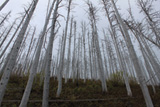“Each soil has had its own history. Like a river, a mountain, a forest, or any natural thing, its present condition is due to the influences of many things and events of the past.”
- Charles Kellogg, The Soils That Support Us, 1956
Soils
In collaboration with Derek Milner, Soil Scientist,
Flathead National Forest
Humans and all other terrestrial animals depend on soil for life. Soil is the unconsolidated mineral and organic material on the earth’s surface that serves as the medium for the growth of land plants. Its formation is the product of climate and organisms, conditioned by topography, acting on parent material over a period of time. Soils are characterized by horizons, or layers, that are distinguishable from parent material as a result of changes over time. Often overlooked, soil is a beautifully intricate and sometimes fragile substance that all terrestrial organisms depend on for their existence.
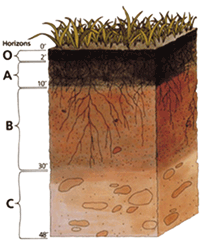 |
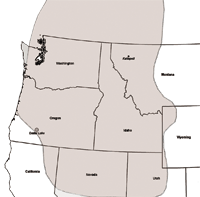 |
|
| Figure 2.7: General Soil Layers. Source: U.S. Forest Service |
Figure 2.8: Estimated spatial distribution of Mount Mazama volcanic ash. Source: D. Milner, U.S. Forest Service |
The Flathead Watershed has a wide diversity of soil types from the minimally developed, nutrient-poor soil and rock outcrop complexes of the steep mountain slopes and ridges to the deep, fertile soils of the lower valleys. Cooler temperatures, shorter growing seasons and steep topography are the prime factors behind the lack of soil development in the upper elevations of the Flathead Watershed. Conversely, the warmer temperatures, longer growing season and gentle topography in the Flathead Valley provide excellent conditions for soil development.
Although lacking local volcanoes, many soils in the Flathead Watershed owe their productivity to volcanic activity. Volcanic ash from the eruption of Mount Mazama (now Crater Lake) approximately 7,000 years ago has significantly influenced forested soils of the area. These ash-influenced soils can be found throughout the western United States as seen in Figure 2.8.
Locally, these soils are characterized by a bright brown “cap” of volcanic ash six inches (15 cm) or more in thickness (Figure 2.9). These ash-cap soils are important to forest management due to their lower bulk density, higher porosity, higher infiltration and higher water retention than other soils. These properties reduce drought stress on plants during extended summer dry periods found in the Flathead Watershed.
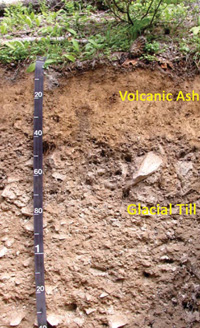 |
| Figure 2.9: Typical ash-cap soil profile, wind-deposited volcanic ash over glacial till. Source: U.S. Department of Agriculture |
Soils in the mountainous portion of the Flathead Watershed can be divided into four functional groups. These groups are presented in descending order by elevation and ascending order by relative productivity:
- Soils on cirques and alpine ridges
- Soils on glacial trough walls
- Soils on moraines and glaciated mountains
- Soils on stream valley bottoms, terraces and kames
Soils in these functional groups were formed in place by weathering of Belt rocks and from Belt rock-derived material deposited by glaciers and streams. These functional groups primarily support forested vegetation and almost all soils in these groups exhibit presence of volcanic ash surfaces.
Soils in the Flathead Valley portion of the Flathead Watershed can be divided into four functional groups as well:
- Soils on sloping glacial outwash fans extending from adjacent mountains
- Soils on glacial moraines
- Soils on lacustrine and glacial stream-laid terraces
- Soils on floodplains and terraces of the Flathead, Whitefish and Stillwater rivers
Soils in these functional groups developed in Belt rock-derived material deposited by glaciers, glacial streams and modern streams and rivers. These first two functional groups primarily support forested vegetation, and some soils in these groups exhibit presence of volcanic ash surfaces. The final two groups developed under grassland vegetation and are the site of the most productive cultivated soils in the Flathead Watershed.
Prime farmland is land having the best combination of characteristics for producing food and fiber. Within the Flathead Valley there are approximately 29,300 acres (11,857 hectares) of prime farmland. Most of these soils are classified as mollisols; soils characterized by their thick, dark, nutrient-rich surface horizons. For better or worse, prime farmland also tends to be well suited to “growing” houses and much of the recent development in the Flathead Valley has occurred on these lands. An excellent example of a prime farmland soil is the Creston Series found in the east-central part of the Flathead Valley. This series is characterized by deep, dark, silty soils developed on glacial outwash terraces. The dark surface horizon is, on average, about 1 foot thick. Winter wheat is the primary crop on these soils.
Soil is dynamic from the moment it begins to develop. It is crucial for agriculture, water purification, development, and maintaining overall biodiversity. A number of natural factors continually alter and renew the composition and character of soil, including time, climate, and biological processes. Some human activities such as using fertilizers, spilling contaminants, deforestation, overgrazing, and erosion caused by development can degrade soil and reduce its functionality. It is therefore important to understand our soils and protect them from overuse and damage so there will be healthy, productive soils in the watershed long into the future.
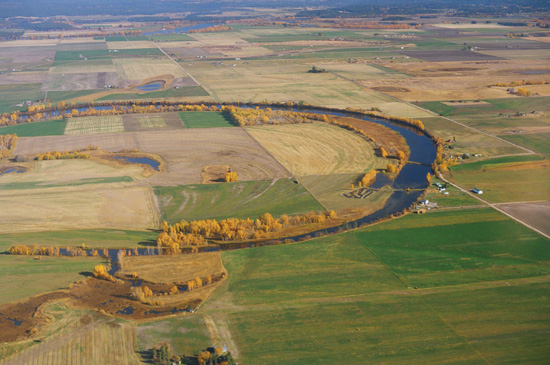 |
| Figure 2.10: Flathead Watershed cropland. Source: Karen Nichols |

